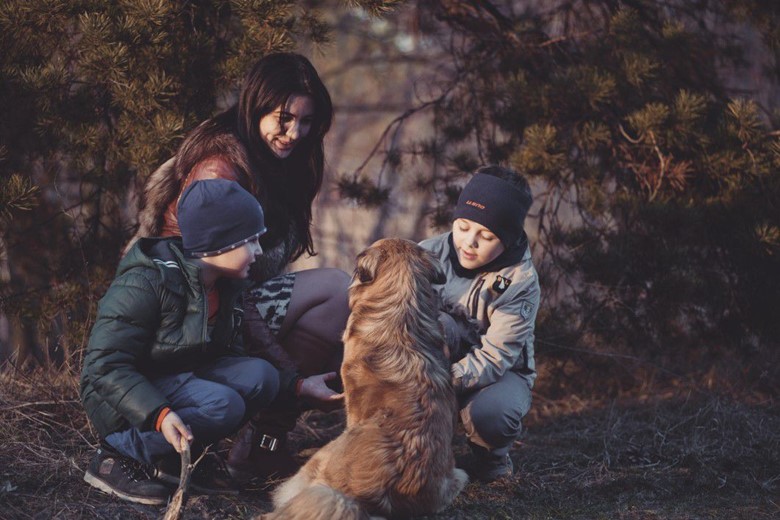Growing up, I never had a pet dog. My parents, both working professionals, had to balance their employment schedules with raising four children, and it was simply not in the cards for our family. While we had fish, birds, and even turtles, my siblings and I attempted to use our best persuasion skills to convince my parents that we could somehow manage to take care of a dog whilst being in school all day. This, of course, was unrealistic and we instead turned to the skill of radical acceptance.

Many of my close friends and relatives had pet dogs, which they treated as equal members of their families and offered a lot of joy. I got to share this joy with my best friend, who still has a video of us on the telephone when we were eight years old, moments after her parents had brought home their new puppy. We were ecstatic!
As a clinician, I have often heard from my young clients that spending time with their family pets helps them cope. When explored, they share that they cuddle, walk and play with their dogs, cats, bunnies, and more. Most often, this is the first response I get when inquiring about the ways that they tolerate anxiety and depression. They share that they turn to their pets for distraction and comfort; to feel a sense of connection; and to establish a sense of purpose and responsibility, especially when motivation is at its lowest point. Many of my colleagues in mental health share the joys that their family pets offer for the same reasons. I see the excitement they have when leaving work to reunite with them. I have also witnessed the concern they have when their pets are faced with illness.

A couple of years ago, I was walking through the halls of a hospital and noticed a big, fluffy dog being encouraged by a woman to greet an elderly man, standing just a few feet in front of her. At first, I assumed they were visitors of a patient; however, I quickly came to understand that they were regular guests in the hospital. I would frequently see them passing by the cafeteria on my lunch breaks, and when I finally had a moment to approach them, I learned that the owner was a trained volunteer who had arranged to have her dog greet terminally ill patients weekly.
A few months later, I attended a Lunch and Learn at the hospital on the topic of service dogs for mental health. This had been organized due to an influx of patients requesting from staff to write letters of support for mental health service pets. Around this time, I also attended a conference and met a young woman who brought her support dog along with her to help mitigate her symptoms of social anxiety. This reminded me of the time in my graduate studies when my academic cohort received an invitation during our exam period to go play with puppies in the University Community Centre to reduce stress levels associated with academic pressures.

During the pandemic, we have seen a striking surge of pets being fostered, adopted, and acquired into family homes, especially dogs, and I often wonder how much this pandemic has affected them. Are they happier because they are spending more time with their families? Are they tired because they are the first responders to distress? Are they developing their own symptoms of anxiety because of their limited exposure to other pets? I hear directly from caregivers that having their pets in the family room increases their child’s motivation to leave their bedroom and improves the quality of time spent together as a family. Notably, I work with one client who is in boarding school, and she exclaims that there are several “campus dogs” that wander around and offer comfort to the students. She has reported that this helps to reduce her feelings of loneliness, especially when she is missing her family.
I have also read about young students in elementary school, facing reading difficulties, going to dog shelters to practice their reading skills in front of the animals. One study concluded that “reading to a dog may have a beneficial effect on a number of behavioural processes which contribute to a positive effect on the environment in which reading is practiced, leading to improved reading performance” (Hall et al., 2016). TIME Magazine also released an article, which highlights that “people who have pets tend to have lower blood pressure, heart rate and heart-disease risk than those who don’t. Those health boons may come from the extra exercise that playing and walking require, and the stress relief of having a steady best friend on hand” (Oaklander, n.d.). Another article in News in Health emphasizes how “animals can reduce loneliness, increase feelings of social support, and boost your mood” (NIH, 2018).

There is no shortage of information to reinforce the physical and mental health benefits of having a pet. But as a therapist, the benefits of meeting my clients’ pets have simply been one of the greatest and mutually beneficial joys of providing virtual therapy. In doing so throughout the pandemic, I have met more pets virtually than I have in my lifetime.
Prior to the pandemic, we would welcome children and families to come into the clinic setting for in-person appointments. When the pandemic started, we quickly pivoted to relying on virtual therapy as our primary mode of providing care. In doing so, I came to realize I had been missing crucial members of the family in my therapy sessions. Having pets participate in sessions helps to alleviate distress, comfort clients as they reflect on their challenges and expose their greatest vulnerabilities. Virtual therapy has not only reinforced the benefits of having pets when struggling with mental health conditions, but the importance of including pets in the process of therapy treatment. By including pets in the therapeutic process, their essential role in caring for my patients struggling with mental health conditions has become “pawsitively” clear.

References
Hall, S. S., Gee, N. R., & Mills, D. S. (2016). Children reading to dogs: A systematic review of the literature. PloS one, 11(2), e0149759. https://journals.plos.org/plosone/article?id=10.1371/journal.pone.0149759
National Institutes of Health [NIH]. (2018). The power of pets: Health benefits of human-animal interactions. News in Health. https://newsinhealth.nih.gov/2018/02/power-pets
Oaklander, M. (n.d.). Science says your pet is good for your mental health. TIME. https://time.com/collection/guide-to-happiness/4728315/science-says-pet-good-for-mental-health/







